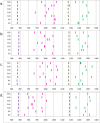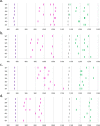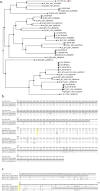Development and optimization of a hybridization technique to type the classical class I and class II B genes of the chicken MHC
- PMID: 31761978
- PMCID: PMC6900278
- DOI: 10.1007/s00251-019-01149-2
Development and optimization of a hybridization technique to type the classical class I and class II B genes of the chicken MHC
Abstract
The classical class I and class II molecules of the major histocompatibility complex (MHC) play crucial roles in immune responses to infectious pathogens and vaccines as well as being important for autoimmunity, allergy, cancer and reproduction. These classical MHC genes are the most polymorphic known, with roughly 10,000 alleles in humans. In chickens, the MHC (also known as the BF-BL region) determines decisive resistance and susceptibility to infectious pathogens, but relatively few MHC alleles and haplotypes have been described in any detail. We describe a typing protocol for classical chicken class I (BF) and class II B (BLB) genes based on a hybridization method called reference strand-mediated conformational analysis (RSCA). We optimize the various steps, validate the analysis using well-characterized chicken MHC haplotypes, apply the system to type some experimental lines and discover a new chicken class I allele. This work establishes a basis for typing the MHC genes of chickens worldwide and provides an opportunity to correlate with microsatellite and with single nucleotide polymorphism (SNP) typing for approaches involving imputation.
Keywords: Avian; BF1; BF2; BLB1; BLB2; Recombination.
Conflict of interest statement
The authors declare that they have no conflict of interest.
Figures










Similar articles
-
Different evolutionary histories of the two classical class I genes BF1 and BF2 illustrate drift and selection within the stable MHC haplotypes of chickens.J Immunol. 2007 May 1;178(9):5744-52. doi: 10.4049/jimmunol.178.9.5744. J Immunol. 2007. PMID: 17442958
-
Single locus typing of MHC class I and class II B loci in a population of red jungle fowl.Immunogenetics. 2008 May;60(5):233-47. doi: 10.1007/s00251-008-0288-0. Epub 2008 Apr 4. Immunogenetics. 2008. PMID: 18389232
-
High-resolution typing for chicken BF2 (MHC class I) alleles by automated sequencing.Anim Genet. 2005 Oct;36(5):432-4. doi: 10.1111/j.1365-2052.2005.01331.x. Anim Genet. 2005. PMID: 16167988
-
A potential nomenclature for the Immuno Polymorphism Database (IPD) of chicken MHC genes: progress and problems.Immunogenetics. 2020 Feb;72(1-2):9-24. doi: 10.1007/s00251-019-01145-6. Epub 2019 Nov 18. Immunogenetics. 2020. PMID: 31741010 Free PMC article. Review.
-
The search to understand the development of the chicken immune system: Differences in expression of MHC class I loci and waves of thymocytes as evolutionary relics?Dev Biol. 2025 Mar;519:38-45. doi: 10.1016/j.ydbio.2024.12.006. Epub 2024 Dec 16. Dev Biol. 2025. PMID: 39694171 Review.
Cited by
-
Single-cell RNA sequencing of bone marrow reveals the immune response mechanisms of lymphocytes under avian leukosis virus subgroup J infection.Poult Sci. 2025 May;104(5):104995. doi: 10.1016/j.psj.2025.104995. Epub 2025 Mar 8. Poult Sci. 2025. PMID: 40121758 Free PMC article.
-
Transcriptomic Analysis of Spleen Revealed Mechanism of Dexamethasone-Induced Immune Suppression in Chicks.Genes (Basel). 2020 May 6;11(5):513. doi: 10.3390/genes11050513. Genes (Basel). 2020. PMID: 32384708 Free PMC article.
-
Fourth Report on Chicken Genes and Chromosomes 2022.Cytogenet Genome Res. 2022;162(8-9):405-528. doi: 10.1159/000529376. Epub 2023 Jan 30. Cytogenet Genome Res. 2022. PMID: 36716736 Free PMC article. Review. No abstract available.
-
A genome-wide scan to identify signatures of selection in two Iranian indigenous chicken ecotypes.Genet Sel Evol. 2021 Sep 9;53(1):72. doi: 10.1186/s12711-021-00664-9. Genet Sel Evol. 2021. PMID: 34503452 Free PMC article.
References
-
- Argüello JR, Little AM, Bohan E, Goldman JM, Marsh SG, Madrigal JA. High resolution HLA class I typing by reference strand mediated conformation analysis (RSCA) Tissue Antigens. 1998;52:57–66. - PubMed
-
- Atkinson D, Shaw I, Jacob J, Kaufman J (2001) DM gene polymorphisms: co-evolution or coincidence? In Proceedings of the Avian Immunology Research Group, 7-10 October 2000. Ithaca NY Edited by KA Schat:163–165
-
- Babik W. Methods for MHC typing in non-model vertebrates. Mol Ecol Resour. 2010;10:237–251. - PubMed
-
- Boonyanuwat K, Thummabutra S, Sookmanee N, Vatchavalkhu V, Siripholvat V. Influences of major histocompatibility complex class I haplotypes on avian influenza virus disease traits in Thai indigenous chickens. Anim Sci J. 2006;77:285–289.
-
- Bryceson YT, Chiang SC, Darmanin S, Fauriat C, Schlums H, Theorell J, Wood SM. Molecular mechanisms of natural killer cell activation. J Innate Immun. 2011;3:216–226. - PubMed
Publication types
MeSH terms
Grants and funding
LinkOut - more resources
Full Text Sources
Research Materials
Miscellaneous

